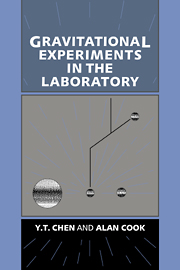Book contents
- Frontmatter
- Contents
- Preface
- 1 Introduction
- 2 The linear oscillator driven by thermal noise and with electrical damping
- 3 External sources of noise and design of experiments
- 4 The weak principle of equivalence
- 5 Verification of the weak principle of equivalence for free particles
- 6 Newtonian attractions of extended bodies
- 7 Experimental tests of the inverse square law
- 8 The constant of gravitation
- 9 Conclusion
- References
- Index
4 - The weak principle of equivalence
Published online by Cambridge University Press: 10 October 2009
- Frontmatter
- Contents
- Preface
- 1 Introduction
- 2 The linear oscillator driven by thermal noise and with electrical damping
- 3 External sources of noise and design of experiments
- 4 The weak principle of equivalence
- 5 Verification of the weak principle of equivalence for free particles
- 6 Newtonian attractions of extended bodies
- 7 Experimental tests of the inverse square law
- 8 The constant of gravitation
- 9 Conclusion
- References
- Index
Summary
Introduction
The essence of the principle of equivalence goes back to Galileo and Newton who asserted that the weight of a body, the force acting on it in a gravitational field, was proportional to its mass, the quantity of matter in it, irrespective of its constitution. This is usually known as the weak principle of equivalence and is the cornerstone of Newtonian gravitational theory and the necessary condition for many other theories of gravitation including the theory of general relativity. In recent times, however, it was found that the weak principle of equivalence was not sufficient to support all theories and the principle has been extended as (1) Einstein's principle of equivalence and (2) the strong principle of equivalence.
Following a brief discussion of the principle of equivalence, this chapter is devoted to an account of the principal experimental studies of the weak principle of equivalence.
Einstein's principle of equivalence
Gravitation is one of the three fundamental interactions in nature and a question at the heart of the understanding of gravitation is whether or how other fundamental physical forces change in the presence of a gravitational force.
Einstein answered this fundamental question with the assertion that in a non-spinning laboratory falling freely in a gravitational field, the non-gravitational laws of physics do not change. That means that the other two fundamental interactions of physics – the electro-weak force and the strong force between nucleons – all couple in the same way with a gravitational interaction, namely: in a freely falling laboratory, the non-gravitational laws of physics are Lorentz invariant as in the theory of special relativity.
- Type
- Chapter
- Information
- Gravitational Experiments in the Laboratory , pp. 58 - 96Publisher: Cambridge University PressPrint publication year: 1993



